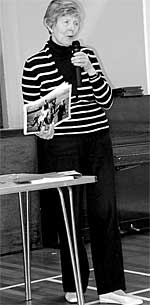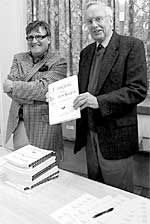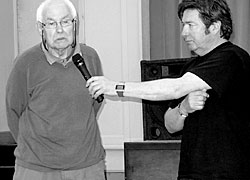Events and excursions, Spring 2012

Oxton Local Historian, Margaret Cooper introducing the film.

David Bagley and Professor Martyn Bennett distributed copies of the Transactions.
The Spring Meeting 2012
Towards the end of the wettest April since records began, we managed to have a dry day for our Spring Meeting and AGM in Oxton on 28th April. There were good numbers once again for the meeting in the very well appointed Oxton Village Hall.
After the usual welcome by our President, Dr. Rosalys Coope, the AGM took place chaired by Professor John Beckett. This year the business included approval of some fairly minor changes to the constitution which will now go to the Charity Commissioners for approval. Two new members were elected to Council, Andy Nicholson, our Webmaster, and Ceril Little; also two new officers, Martyn Bennett as our new Transactions History editor and Judith Mills as the Membership Secretary – we welcome them all.
In his Chair’s remarks, Professor Beckett informed members that Council was committed to maintaining the size of the well-respected and attractive Newsletter, even though the postage costs would be higher. He also spoke of plans to explore other ways of making sure that members are fully informed of events and matters of interest as quickly as possible. Following the commitment to support and promote research made last year, John was able to inform members of the establishment of two new groups, the Research Group and the Victoria County History for Nottinghamshire Group.
Both are now formally sections of the Society. He thanked all the officers for their work this year and for their continuing support.
Following the business of the AGM, members were treated to a film, introduced by local historian Margaret Cooper and filmed by Adrian Todd, about some of the most interesting historic features of Oxton – its hillfort, the church, blacksmithing and farming, the tree planting that celebrated success at the end of the Napoleonic wars, a splendid well in process of excavation and more. (Ed: Barbara modestly fails to mention here starring role in this film where she commented upon and described the hill fort site).
We then enjoyed a splendid tea, this time not a WI tea but very amply supplied by Catherine’s Bakery of Calverton. Not having the WI in charge meant a lot more work for a number of members and so I give a big thank you to all of them – I hope your hands have recovered from the washing up!

Oxton historian, Colin Ashmore and film-maker Adrian Todd answer questions from the audience about the film.
After tea we moved across the road to the church where Colin Ashmore gave an interesting and entertaining explanation of the church’s features. Following this many of the members went for a walk around the village, led by Colin and Margaret.
Again it was a very enjoyable day so, if you haven’t yet attended one of our Spring Meetings, it can be thoroughly recommended.
BARBARA CAST
10 MARCH 2012, THE MAURICE BARLEY LECTURE
THE EARLY WEST FRONT OF LINCOLN CATHEDRAL by David Taylor
Maurice Barley was brought up within a short distance of Lincoln cathedral, and so it was highly appropriate that this year’s lecture was given by Dr. David Taylor of the Department of Archaeology at the University of Nottingham, who worked with Maurice earlier in his career, and spoke about his own work on the west front of Lincoln cathedral in its earliest days in the late 11th and early 12th centuries. The front is all that now remains above ground of the first cathedral, most of the present-day church having been built onto it in the following centuries. Previous work had concentrated mainly on the Romanesque decorative frieze running across its façade, but it was argued in 1997 by Alan Vince and David Stocker that the first building was originally a defensive free-standing tower later attached to the body of the church. Dr. Taylor has tried, through a detailed survey carried out over a period of six years, to establish for the first time what can be learned about the sequence of building during those early years by deduction from his study of four of the 36 voids and chambers that lie behind the façade.
He identified three phases of building. The first went up to a distinct break in the building just above where the frieze is now, and within the interiors on both the north and south sides there is evidence of heavy burning, a feature not previously identified and not visible on the outside of the building. He concluded that this fire brought the first phase of building to an end. The builders of the second phase made marks, in the form of a crude diagonal cross, on some of the burnt stones which it was thought could be saved and re-used. They were used to help raise the height of the wall, but whether this work was completed is not clear because it was superseded by the ambitious third stage, which built much higher still and began the work on the western towers, as well as adding the Romanesque frieze. The first phase was that built during the lifetime of Bishop Remigius after 1072, during which the cathedral was consecrated in 1093 before it was burnt. Dr. Taylor thinks that this fire was an earlier one than the recorded ones of 1124 and 1141, and that the second phase may have been begun by Bishop Robert Bloet (1094-1123), with the third being commenced under Bishop Alexander (1123-48) and perhaps continuing under Robert de Chesney (1148-67) and even Bishop-elect Geoffrey Plantagenet after 1174, during whose time bells are known to have been placed in the towers.
Dr Taylor concluded with a critique of the idea that the first building was defensible and possibly a free-standing tower, and included structures possibly to be identified as arrow-slits, machicolations and garderobes. He re-interpreted some of these features as possibly being connected with religious ceremonial as singing galleries rather than defence. The talk was illustrated with excellent photographs, diagrams and coloured drawings of important sections of stonework. Dr. Taylor’s work has already been published in the Archaeological Journal, volume 167 (2010), where it is possible to read the full argument in detail and see the colour illustrations of the structures on which it is based.
David Crook
THE TRENT VALE PROJECT – UPDATE
Readers will recall an article in issue 66 (Winter 2011) about the Trent Vale Landscape Project event at Low Marnham.
On Monday and Tuesday 23/24 April 2012, the Project held a workshop at Norwell Village Hall where Gillian and David Wing of Strawberry Glass, Spalding, (www.strawberryglass.co.uk) taught attendees the basics of working in leaded glass. The workshop was limited to 10 participants to ensure good individual tuition and there was a waiting list of almost twice this number, proving the popularity of the event.
The intended theme for the pieces produced at the workshop was to be inspired by the Trent Valley landscape and/or local ecclesiastical glass; however, wide interpretation of the theme was allowed.
Day one was taken up by learning how to cut glass, selecting suitable glass, creating a cartoon to work from and grinding glass. At the end of this day, each student had a piece made up of cut and prepared glass and we all showed them on a light-box and discussed the motivation for the piece.
Day two involved the preparation of lead came, fitting the cut pieces into the lead, soldering the lead, attaching hanging hooks and the final cementing of the panel.

Left: At the light box | Centre: Working on the cartoon | Right: final cementing. Photographs courtesy of John Redgrove from colour originals.
Each day was full of hands-on activity and we were all rather tired at the end of each day. However, this was offset by the exhilaration of having created a piece of work which, without exception, looked very good. This was in great part due to the skill, patience and help of our tutors who were excellent in showing how to undertake each task and in helping us as individuals when we required advice – which was not infrequent! However, the final pieces were our own work.
This was a very successful workshop, the group, from diverse backgrounds, gelled from the start and on each day there was a great buzz between participants and tutors. The Trent Valley Project is to be congratulated on a most successful event which will have lead several participants on to a new craft activity.
Howard Fisher